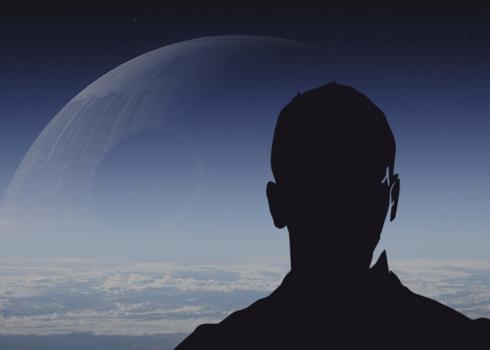MyPath Q&A with the Death Star's Chief Risk Officer

The newest Star Wars film, “Rogue One: A Star Wars Story,” depicts the planning and construction of the original Death Star. It’s a prequel to the first film in the famous franchise, released in 1977, in which we watch the moon-sized weapon vaporize an entire planet using a superlaser.
Spoiler alert: This Death Star doesn’t last too long. The rebels are able to steal the blueprints, find a weakness and destroy it. The Empire builds two more similar weapons, but both are similarly destroyed.
This series of defeats has raised a lot of questions about the Empire’s approach to risk management. To learn more, we reached out to the Chief Imperial Risk Officer of the Galactic Empire for comment. Given the threat of retaliation by prominent Sith lords, we withheld the name. What follows is an edited transcript of our conversation.
MyPath: Thank you for taking the time to speak with us. We know that you’re risking a lot by doing so.
Chief Imperial Risk Officer: Of course. This was certainly a long time ago, in a galaxy far, far away, but it still feels like it happened yesterday. Nevertheless, I believe that the risk and insurance profession is strongest when we openly analyze mistakes so that we can prevent them from happening again.
MyPath: Let’s start with the first Death Star. Rebel forces were able to destroy it by exploiting an open exhaust shaft. What do you think could have been done better to manage that risk?
CIRO: I appreciate your asking that question, because I do feel that the risk management failures at the first Death Star have been oversimplified.
We did a careful risk analysis and, given that every analyst in our star system agreed that the Jedi were most likely extinct, we made a calculated risk assessment to move forward with the prevailing design. I would also mention that we didn’t have anything close to the capabilities of today’s catastrophe modeling vendors.
Furthermore, I think that we did a stellar job—no pun intended—given the challenges of the mission. You don’t have to take my word for it. The amount of planning, labor and materials that went into the construction were astronomical. Sorry, another pun.
Seriously, though, it cost almost $8 octillion a day to operate that thing, which is about 30 trillion times the entire Earth’s gross domestic product. The fact that we were able to build and run the space station with minimal worksite injuries and project delays is a major testament to the work of the entire Imperial Risk Management Department.
MyPath: Was the Empire able to recoup any of its losses through insurance?
CIRO: While there is insurance for space ships, war is excluded in nearly all insurance policies, and that includes the Galactic Civil War. That’s because war is basically impossible to insure against—it’s unpredictable, and if an entire fleet were destroyed and an insurer had to cover the loss, it would likely go bankrupt and not be able to pay anyone. NPR’s Planet Money had a good episode about that.
On a related note, I am proud of the fact that the families of the more than 1.7 million stormtroopers and other soldiers killed in the destruction of the Death Star were entitled to receive life insurance benefits, which were covered by the Imperial Government. These types of payouts are standard practice for many military outfits. I’m a little less proud of the fact that the emperor used the dark side of the Force to convince all the families that they didn’t need the payout, essentially committing the greatest insurance fraud of all time. You win some, you lose some.
MyPath: What about the second Death Star? Given what you learned the first time around, do you feel that the risks could have been managed better there?
CIRO: Well, of course, and to be frank, we identified a number of risks with Death Star II, but the emperor chose to ignore them. It really is a tragic case study of what goes wrong when you don’t properly manage risk.
First, we knew that construction was going to be delayed because the Empire simply didn’t allocate enough workers to the project. We were forced to hire independent contractors by the thousands in order to stay on track.
Second, we predicted that there would be substantial resistance from the indigenous Ewoks on Endor and that our AT-STs could be easily ambushed in the dense jungle. The military didn’t care, which was par for the course. I mean, I had been telling them for years that their tanks made no sense, but no one listened.
Last but not least, we all know that it was a trap, but I strongly urged Empire leadership to at least fortify the power generator. Like, it took only five shots from an X-wing and a souped-up light freighter to take it out. Despite this clear vulnerability, the emperor relied far too heavily on the likelihood of the shield’s staying up. It may be one of the worst risk management mistakes in galactic history!
MyPath: In your time with the Galactic Empire, did it ever concern you that your risk management skills were being used for evil?
CIRO: That’s a fair question, and it really speaks to the issue of reputational risk, a.k.a. a loss resulting from damage to an organization’s reputation. Admittedly, the Empire’s made some regrettable decisions over the years, which has certainly hurt its reputation, but I believe that it’s unfairly disparaged by rebel propaganda and Jedi mind tricks.
Clearly, the “Star Wars” series of documentaries have a strong light-side bias. John Williams composes a heroic theme for the Jedi yet gives the Empire an ominous-sounding march? He didn’t even consult with us to incorporate our beautiful and lyrical Imperial Anthem into his score.
Meanwhile, you never hear about all the good things the Empire’s done. Both Death Stars were tremendous job programs, putting millions of people to work.
Meanwhile, the rebels made it seem like the second Death Star’s destruction resulted in one big, happy dance party when in reality, Endor was incinerated. You never hear any mention of that.
MyPath: Thirty years after that, we saw yet another super-weapon, Starkiller Base, be destroyed—once again—by an attack on its core. Were you involved at all in managing risk there, too?
CIRO: No, thankfully not. The destruction of the second Death Star caused an economic collapse throughout the Empire, and I simply opted to retire and take up pod racing. People say that it’s a risky sport, but I’ve always found that people who take the biggest risks also happen to be the best risk planners.
